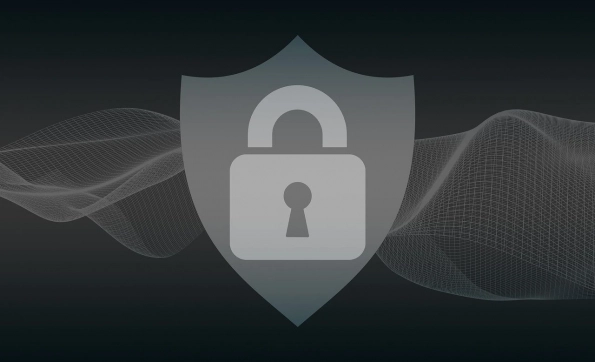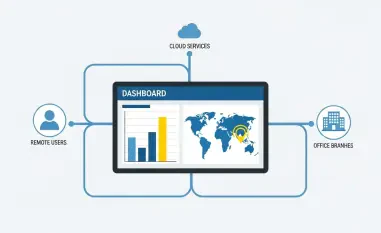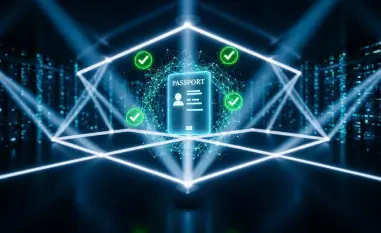The threats to digital security are ever-evolving, necessitating continuous adaptation in cybersecurity practices by both individuals and organizations. This article collates expert insights to furnish practical strategies for strengthening digital defenses in an increasingly complex cyber environment. As cyber threats grow in sophistication, understanding the landscape and implementing tailored security measures becomes imperative for safeguarding valuable information.
Understanding the Threat Landscape
Increasing Sophistication of Email-Based Attacks
Email continues to be a significant threat vector despite widespread awareness and training efforts. According to Nicole Carignan from Darktrace, an alarming 17.8 million phishing emails were detected between December 2023 and July 2024. This statistic underscores the advanced techniques now employed by cybercriminals. Modern platforms such as Microsoft Teams and Dropbox have become new avenues for these attacks, making the threat landscape more complex. Carignan emphasizes that depending solely on employees as the last line of defense is insufficient. Organizations must adopt machine learning tools that analyze user behavior to identify anomalies. With the rise of deepfake technologies, which can convincingly mimic real people, multi-layered security systems are more important than ever. These systems should include multi-factor authentication and AI-augmented detection mechanisms to thwart sophisticated phishing attempts effectively.
Furthermore, cybercriminals are continuously refining their tactics to bypass traditional email security measures. Attacks are no longer limited to poorly written, easily identifiable phishing emails. Instead, they now often involve well-crafted messages that appear legitimate, making them harder to detect. Organizations must stay ahead of these evolving threats by developing dynamic and robust email defense strategies. By leveraging advanced analytic tools and artificial intelligence, companies can better predict and prevent phishing attacks before they can penetrate their systems.
Role of Ethical Hackers
The cybersecurity landscape is also witnessing a paradigm shift with the increased involvement of ethical hackers, also known as white-hat hackers. Justin Kestelyn of Bugcrowd highlights the significant contributions of the global hacker community in enhancing cybersecurity measures. Ethical hackers offer a scalable and on-demand security testing capability far superior to what automated tools can achieve. This becomes particularly crucial given the chronic talent shortage in the cybersecurity industry. Organizations like Bugcrowd tap into this extensive pool of skilled individuals, providing a flexible and potent layer of security.
Ethical hackers work by simulating potential cyberattacks to identify vulnerabilities that might be missed by automated systems. They offer fresh perspectives and innovative solutions, making them an invaluable resource in the constant battle against cyber threats. This approach not only helps in identifying and fixing security gaps but also fosters a culture of continuous learning and improvement within organizations. By embracing the contributions of these adept individuals, companies can significantly bolster their cybersecurity defenses, effectively staying one step ahead of malicious actors.
Protecting Digital Identities and Mobile Devices
Emphasis on Mobile Security
In the realm of mobile security, the importance of protecting digital identities cannot be overstated. Kern Smith from Zimperium underscores that iOS and Android devices, which are repositories of vast amounts of personal and corporate data, are prime targets for cyberattack. Mobile phishing, malware, and vulnerabilities within third-party apps pose significant risks to mobile security. Unlike traditional attack vectors, mobile devices often lack the same level of security infrastructure. Smith recommends comprehensive strategies to identify and prevent phishing attacks, detect malware, and thoroughly assess app vulnerabilities. These strategies are vital for safeguarding user credentials and maintaining the integrity of digital identities.
Mobile devices are increasingly becoming the nexus of digital identities, making their security paramount. As these devices store and facilitate access to critical information, any compromise can have far-reaching consequences. Therefore, it is essential to implement robust mobile security solutions that can preemptively identify and eliminate threats. This includes regular security audits, timely updates, and user education to recognize and avoid potential risks. Additionally, leveraging tools that continuously monitor and adapt to new threats can significantly enhance mobile security, providing a more resilient defense against cyberattacks.
Strategic Cybersecurity Investments
The conversation around cybersecurity investments is gaining traction, especially concerning their adequacy and effectiveness. Jose Seara from DeNexus emphasizes the importance of strategic spending in cybersecurity. He points out that many organizations are uncertain whether their cybersecurity expenditures are sufficient or well-allocated. Seara advocates for evaluating cyber risks in financial terms, allowing organizations to prioritize investments that offer the highest returns, particularly by mitigating the likelihood of significant cyber incidents. This approach ensures that funds are directed towards areas that will have the most substantial impact on overall security.
Strategic investments in cybersecurity are not just about spending more but about spending wisely. Organizations must identify key areas where investments will yield the most significant benefits, such as enhancing threat detection capabilities or fortifying critical infrastructure. By aligning cybersecurity spending with organizational priorities and risk profiles, companies can better protect themselves against potential threats. This involves continuous assessment and adjustment of strategies to ensure they remain relevant and effective in the face of evolving cyber risks. A well-thought-out investment strategy can significantly enhance an organization’s ability to prevent, detect, and respond to cyber threats, ultimately safeguarding its assets and reputation.
Preparing for Future Threats
Advancing Quantum-Safe Strategies
The advent of quantum computing presents a new set of challenges for cybersecurity, particularly concerning cryptographic methods. Philip George from InfoSec Global Federal addresses the necessity of adopting quantum-resistant encryption standards as outlined by NIST. With quantum computing capabilities on the horizon, current cryptographic techniques are at risk of becoming obsolete. George advises organizations to begin by automating their cryptographic asset inventory, aligning it with a zero-trust architecture (ZTA), and enhancing cryptographic agility. This foundational step is crucial for the efficient adoption of future quantum-safe algorithms.
The transition to quantum-safe cryptography is not simply a technical upgrade but a strategic imperative. Organizations must prepare for this shift by conducting comprehensive audits of their existing encryption methods and identifying potential vulnerabilities. Implementing quantum-resistant encryption will involve updating protocols, training staff, and possibly overhauling entire systems. However, these efforts are essential for maintaining security in a post-quantum computing world. By proactively addressing these challenges, organizations can ensure their encryption methods remain robust, safeguarding sensitive information against future quantum threats.
Tackling Evolving Technological Threats
The rapid advancement of technology continues to introduce new threats to cybersecurity. Kris Bondi of Mimoto points to the growing dangers posed by tools like deepfakes and ransom-as-a-service platforms. These technologies enable even less sophisticated attackers to carry out highly effective cyberattacks, escalating the threat landscape. Bondi emphasizes the need for organizations to focus on promptly identifying current vulnerabilities and enhancing their response capabilities. Immediate detection and reaction to potential breaches are critical for minimizing damage before cybercriminals can exploit these vulnerabilities.
Technological advancements continuously reshape the cyber threat landscape, necessitating adaptive and proactive security measures. Deepfakes, for instance, can be used to impersonate executives or infiltrate secure communications, creating significant risks for organizations. Similarly, ransom-as-a-service platforms lower the barrier to entry for cybercriminals, increasing the frequency and severity of ransomware attacks. To combat these threats, organizations must invest in advanced threat detection systems, continuous monitoring, and rapid response protocols. Staying informed about emerging threats and regularly updating security practices will help organizations remain resilient in the face of ever-evolving cyber risks.
Integrating AI and Data for Enhanced Security
Importance of Data Management
In the age of artificial intelligence, the role of data management in cybersecurity cannot be overstated. Dan Ortega from Anomali highlights how poor data management practices can significantly increase operational risks. Effective data management is crucial for integrating threat intelligence across various security functions. Ortega calls for regular audits of Security Operations Centers (SOCs) to ensure comprehensive data flows and the effective utilization of AI technologies. By optimizing data management, organizations can enhance their strategic, efficient, and risk-averse operations.
Data management serves as the backbone of effective cybersecurity in the AI era. Accurate, timely, and comprehensive data collection and analysis enable organizations to detect anomalies, predict potential threats, and respond swiftly. This involves not only technological upgrades but also the implementation of best practices for data governance. Ensuring that data is appropriately collected, stored, and managed is vital for leveraging AI capabilities to their fullest potential. Integrated threat intelligence provides a holistic view of the security landscape, enabling more informed decision-making and more robust defenses against cyber threats.
Navigating Regulatory Challenges with AI
As AI technology proliferates, organizations face the dual challenge of fostering innovation while ensuring secure implementation within a complex regulatory landscape. Dana Simberkoff from AvePoint underscores the importance of balancing AI advancement with robust security practices and compliance with regulations. Upcoming regulations will demand comprehensive data strategies to mitigate risks associated with AI. Simberkoff stresses the importance of governance, management, and security policies to prepare for these regulations while protecting against potential cyber threats.
Navigating the regulatory landscape requires organizations to stay informed and proactive in their approach to AI implementation. Compliance with existing and forthcoming regulations will necessitate thorough documentation, regular audits, and continual adjustments to policies and procedures. Robust data governance and security practices are essential components of this strategy, ensuring that AI tools are deployed ethically and securely. By preparing for regulatory challenges, organizations can safeguard their innovative efforts and maintain trust with stakeholders, all while mitigating cybersecurity risks associated with AI.
Conclusion
Digital security threats are constantly changing, making it essential for both individuals and organizations to continuously update their cybersecurity strategies. As these cyber threats become more sophisticated, it is crucial to understand the evolving landscape and implement customized security measures to protect valuable information.
This article gathers insights from experts to provide practical strategies for enhancing digital defenses in an increasingly complicated cyber world. The complexity and frequency of cyber attacks have escalated, demanding stronger and more proactive approaches to cybersecurity.
Individuals and organizations must stay informed about the latest threats and take steps to mitigate risks. This involves regular system updates, using robust passwords, and incorporating multi-factor authentication. Employees should also receive ongoing training to recognize phishing attempts and other common cyber threats.
Moreover, investing in advanced security software and working with cybersecurity professionals can offer an added layer of protection. Organizations should also conduct regular security assessments to identify and address vulnerabilities promptly.
Understanding the cyber threat landscape and implementing these tailored security measures are crucial for maintaining the integrity and confidentiality of sensitive information. By staying vigilant and proactive, both individuals and organizations can better defend against the ever-evolving threats in the digital realm.













